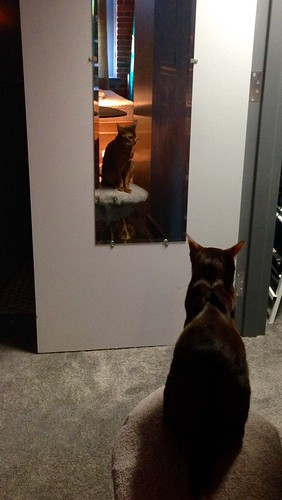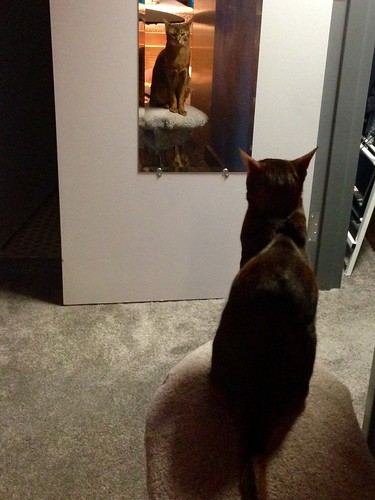A few weeks ago, there was a post on the Facebook Abyssinian Cat Club about Caracats. Caracats are a hybrid of Abyssinians and Caracals. My friend TJ Banks, inspired by this post, wrote an article about Caracats for Pets Adviser. Well, now it’s my turn.

I’m against wild/domestic hybrids in general (all species, not just cats) because they tend to dilute the wild species. Granted, this does happen naturally, but Scottish wildcats and American red wolves are almost extinct as distinct species and part of the reason is because of hybridisation. In the Scottish wildcats’ case, it’s interbreeding with domestic cats and in the red wolves’ case it’s interbreeding with coyotes…although an argument can be made that this can also be blamed on human intervention which enabled the coyotes to expand their range into the red wolves’ natural territory. Even when it happens naturally, hybridisation it is bad news for wild species. Messybeast has an in-depth article about wildcat-domestic cat hybrids that is well worth reading.
Another problem is that lot of cat rescues aren’t equipped to handle the early (F1 & F2) wild/domestic hybrids because they’re so wild…but the wildcat sanctuaries won’t take them, either, because they’re not wild cats. It’s a bit like the old fable about the bat, the birds, and the beasts – the hybrids are neither one thing nor the other. So where do they go? Well, a lot of times, they’re put to sleep. Or, they’re “set free” in the wild – which causes problems to the ecosystem. Also, if you read this article…the infertile Caracat male “in-between generations” kittens were being sold as DECLAWED pets. Which tells me that they are too wild to be allowed to go as clawed pets…and declawing is a whole other issue I don’t want to get started on!
Big Cat Rescue has a good article on the subject as well, and it excellently makes an important point: “So many breeders claim that they only breed 4th and 5th generations, but don’t seem to get the fact that you can’t get a 4th generation without a lot of suffering in the first three.” The early generations are, basically, wild cats. Not at lot of the domesticated traits exist until you get to the fourth generation and beyond.
Which brings me to what I think is the biggest problem about Caracats – their wild origin. Caracals, you see, are big. Really big. You may think your Aby is big when he’s lying all over your laptop or taking over half your bed, but that’s just peanuts compared to Caracals.

This is what one looks like lounging on top of your refrigerator.

And THIS is what a regular domestic cat looks like next to a Caracal. Got it? Caracals are big. While yes, I do see the appeal that owning a part-wild cat would hold, especially one that was more “dog-sized”…It’s just not a good idea.
Obviously, this size difference causes issues in getting the Caracals and the Abys to breed. Female Caracals can weigh up to 35lbs/16kg, and an average male Aby would be too small to properly mate with a female Caracal (Jacoby is considered a “larger” Aby, and he only weighs 10lbs/2kg! Male Caracals, weighing up to 40lbs/18kg could easily accidentally injure or kill the smaller female Aby during mating with the “mating bite” that felines use. What’s happening to all the Abys who don’t survive the mating? Yeah, I don’t want to know, either.
Then, even if the male Caracal and the female Aby manage to conceive, there are still problems. The gestation period for Caracals is 73 days, 10 days longer than the domestic Aby’s 63 days. Even if the Aby carries to term, the kittens are still premature from the Caracal’s perspective. But the kittens need to be premature to be born at all; if they were more developed, they would be too big for the Abyssinian mother to be able to give birth to them naturally. Breeders are putting their mother Abys through a lot of stress when these kittens rarely survive. Also, because of the chromosomal differences, first generation male Caracats are usually sterile; only the female kitten can be used for breeding successive generations.
Savannahs (Serval/Domestic crosses) are actually illegal in Massachusetts, although Bengals (African Wild Cat/Domestic crosses) are allowed. I know a lot of people have Bengals and they’re “hardly wild anymore” but they still aren’t domestic cats, and you can achieve the look of them without a drop of wild blood (take the Ocicat, for example…or the Abyssinian!) so why put the wildcats through it? We’ve got plenty of domestic cats with 12,000+ years of domestication behind them. Lately, CFA has been considering recognising hybrid “breeds” like Bengals and Savannahs. These “breeds” are already accepted in TICA. I really hope CFA sticks to their “domestic cat” origins and NEVER accepts the wild hybrids.







